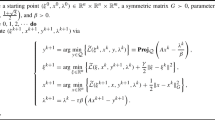Abstract
We propose a general dual program for a constrained optimization problem via generalized nonlinear Lagrangian functions. Our dual program includes a class of general dual programs with explicit structures as special cases. Duality theorems with the zero duality gap are proved under very general assumptions and several important corollaries which include some known results are given. Using dual functions as penalty functions, we also establish that a sequence of approximate optimal solutions of the penalty function converges to the optimal solution of the original optimization problem.
Similar content being viewed by others
References
Andramonov, M. (1999), An approach to constructing generalized penalty functions. In: Rubinov, A. M. and Glover, B. M. (eds), Optimization and Related Topics, Kluwer Academic Publishers, Appl. Optim., 47, 3–14.
Avriel, M. (1976), Nonlinear Programming, Prentice-Hall, Englewood Ciffs, NJ.
Bertsekas, D. P. (1976), Nondifferentiable optimization via approximation, Mathematical Programming 3, 1–25.
Glover, B. M., Rubinov, A. M. and Craven, B. D. (1995), Solvability theorems involving infconvex functions, Journal of Mathematical Analysis and Applications 191, 303–330.
Goh, C. J. and Yang, X. Q. (2001), A nonlinear Lagrangian theory for nonconvex optimization problems, Journal of Optimization Theory and Applications 109, 99–121.
Grossman, Ch. and Kaplan, A. (1979), Straffunktionen und Modifizierte Lagrange-funktionen in der Nichtlinearen optimierund, Texte Zur Mathematik, Leipzig.
Jeyakumar, V. and Wolkowicz, H. (1990), Zero duality gaps in infinite-dimensional programming, Journal of Optimization Theory and Applications 67, 87–108.
Luenberger, D. G. (1984), Linear and Nonlinear Programming, Addison-Wesley, Reading, MA.
Oettli, W. and Yang, X. Q. (2002), Modified Lagrangian and least root approaches for general nonlinear optimization problems, ACTA Mathematicae Applicatae Sinica, English Series 18, 147–152.
Rockaffellar, R. T. (1974), Conjugate Duality and Optimization, CBMS Lecture Notes Series, Vol. 162, SIAM Publications, Philadephia, PA.
Thach, R. T. (1993), Global optimality criterion and a duality with zero gap in nonconvex optimization, SIAM Journal on Mathematical Analysis 24, 1537–1556.
Rubinov, A. M. and Glover, B. M. (1998), Duality for increasing positively homogeneous functions and normal sets, to appear, RAIRO Operations Research 32, 105–123.
Rubinov, A. M., Glover, B. M. and Yang, X. Q. (1999), Modified Lagrange and penalty functions in continuous optimization, Optimization 46, 327–351.
Wang, C. Y. and Zhao, Q. Z. (1989), Existence for nonlinear dual programming, (in Chinese) Chinese Ann. Math. Ser. A 10, 650–659.
Zabotin, Y. I. (1975), A minimax method for solving problems of mathematical programming, Soviet Mathematics (Iz VUZ) 19, 28–33.
Author information
Authors and Affiliations
Rights and permissions
About this article
Cite this article
Wang, C.Y., Yang, X.Q. & Yang, X.M. Nonlinear Lagrange Duality Theorems and Penalty Function Methods In Continuous Optimization. Journal of Global Optimization 27, 473–484 (2003). https://doi.org/10.1023/A:1026028626328
Issue Date:
DOI: https://doi.org/10.1023/A:1026028626328




